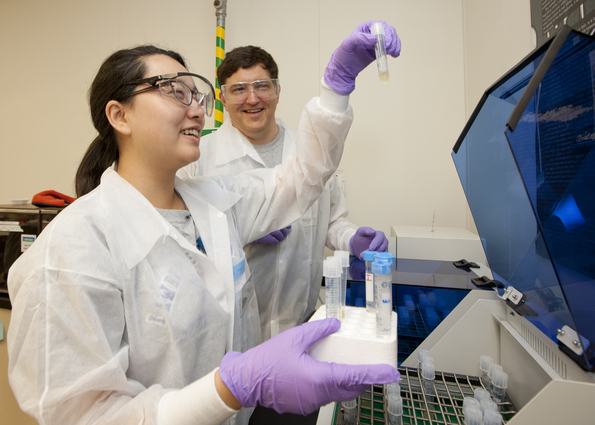Teacher-student teams conduct authentic genomic research
 (Download Image)
(Download Image)
Student So Yun Park prepares a DNA sample for analysis while Andrew Vershon, director of the Waksman Student Scholars Program looks on.
The research will generate and publish novel DNA sequence data on a species of duckweed. The two-week session at the Edward Teller Education Center (ETEC) is part of a new Teacher Research Academy (TRA) in collaboration with the Waksman Student Scholars Program ( WSSP ), sponsored by the Waksman Institute at Rutgers University.
The session uses the WSSP model, funded through the National Science Foundation, which helps high schools connect with the local research community and engage in a genuine research project in molecular biology and bioinformatics.
Hands-on experience introduces students and teachers to the content, background information and laboratory procedures, as well as computational skills that are needed to carry out a research project in molecular biology and bioinformatics that they can conduct at their schools during the academic year.
All students that participate in the project can have the results of their DNA sequence analyses submitted for publication with their names as contributing authors on GeneBank, a DNA sequence database used by scientists throughout the world. Last year, 26 students participating in the initial collaboration published their sequences, with an additional 10 pending publication.
How did the LLNL-Rutgers University partnership come to be? Richard Farnsworth, manager of the Lab's Science Education Program, explains that he was looking to expand the Lab's Teacher Academies -- a continuum program where teachers progress through five levels of instruction, each level building on the knowledge and experience of the preceding level and progressing the teacher from novice to mastery.
Hoping to develop a sixth level with a concentration in biology and bioinformatics, Farnsworth was searching the Internet for information. He hit the jackpot when he learned about the Rutgers program. And, this summer, the bicoastal collaboration came to fruition.
Last year, to usher in the program at Livermore, Farnsworth called upon four teachers to attend the 2011 summer institute at Rutgers University in New Jersey and prepare for their roles as master teachers. The teachers are: Jeff Austin of Modesto High School, Erin McKay of Tracy High School, Katherine Huang of Dougherty Valley High School in San Ramon, and Michael Sana of Waipahu High School in Hawaii. All teach biology and have previously participated in one of LLNL's teacher academies.
In July, the teachers, along with two students each, reunited at ETEC for two weeks for the transition or bridge portion of the program where they will implement the teaching model in the classroom. An additional four teachers and eight students from local high schools also are participating in the two-week Institute. The teachers are: Elizabeth Lopez of Granada High School; Cora Da Costa Pereira and Heather Pereira, both of Amador Valley High School; and Jennifer Hunau of Dougherty Valley High School. Joining the group is Andrew Vershon, a Rutgers professor and WSSP director, and John Brick, laboratory leader, who will provide instruction, lectures and laboratory sessions.
"The program brings science into the classroom in the form of real research." Vershon said. "Students and teachers are learning how to carry out the project together. Having their students present is valuable to the teachers. "
Since its inception in 1993, more than 250 high school science teachers and approximately 3,500 high school students have worked on scientific research investigations with instruction from Waksman faculty and staff.
Vershon added that coming to LLNL benefits the program. It is a way to reach out to more school districts. "I am grateful for the partnership. It is a wonderful interaction," he said. Augustine Chemparathy, a 10th grade student at San Ramon's Dougherty Valley High School, doesn't mind taking some time from his summer vacation to participate. "I am interested in a career in biology," he said, while working in ETEC's computer lab.
Jennica Ramones and Kahealani Uehara of Waipahu High School in Hawaii, traveled to Livermore with Sana, their teacher and school's science department chair.
Uehara has a special interest in the program. She won at her district's science fair with her project, which featured sequencing the DNA of duckweed.
"Not everyone gets to do this," Ramones added. "It is really useful in preparing those interested in the science fields. This is a great opportunity."
Contact
Linda A Lucchetti[email protected]
925-422-5815
Tags
Academic EngagementStudents
Science
Featured Articles







